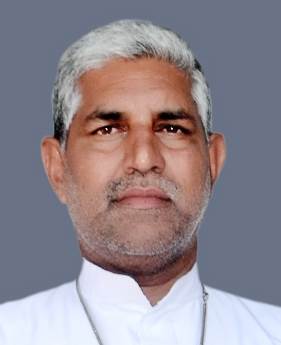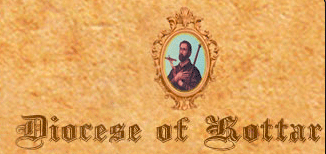


Kottar Diocese
Bishop of Kottar
Kottar Diocese aka Dioecesis Kottarensis has detached from Cochin and then Kottar Diocese was established, later Kuzhithurai Diocese was bifuricated from Kottar Diocese. The Bishop of Kottar diocese was Bishop Nazerene Soosai.
Kottar Diocese
Coat of Arm of Kottar Diocese
St Xaviers
Coat of arm of Bishop Peter Remigius
Coat of arms of Bishop of Kottar
Bishop Nazerene Soosai
History of Kottar Diocese
The Roman Catholic Diocese of Quilon is the first Catholic diocese in India in the city of Kollam. The diocese, which covers an area of 1,950 km². (753 square miles). It was first erected on 9 August 1329.
According to tradition, St. Thomas the Apostle established seven churches along the southern part of west coast of India, and Quilon (Kollam) is the second in the list of the above seven churches. It is claimed to be the world's oldest existing church structure and built by Thomas the Apostle in 57 AD, called Thiruvithamcode Arappally or Thomaiyar Kovil as named by the then Chera King Uthiyan Cheralatan and was succeeded by his son, Nedum Cheralathan in 4th Century. It is located at Thiruvithancode in Kanyakumari District of Tamil Nadu, India.
Quilon Diocese Established on 1329
On 21 August 1329 Pope John XXII appointed the French or Catalan Dominican friar Jordanus Catalani as the first Bishop of Quilon.The ancient diocese of Quilon had extensive jurisdiction over modern nations of India, Pakistan, Afghanistan, Bangladesh, Burma and Sri Lanka.
John De Marignolli (Giovanni de' Marignolli) of St. Lorenzo in Florence, joined the Franciscan order and was consecrated bishop in 1338 AD. He was chosen as legate to China by Pope Benedict XII (1334-1342). He preached in China and on his way back from China, he landed at Quilon and lived there for over a year, preaching in St. George's Church, which was founded by Jordanus and he visited Cape Comorin the extremity of Indian Peninsula.
The Christian community of Quilon after remaining a long period without bishops became a part of the diocese of Goa in 1534, when Goa was made an Episcopal see, suffragan to Funchal in the Madeiras. When Goa was raised to an archbishopric on 4 February 1557, Cochin was made suffragan diocese to the Arch-diocese of Goa and Quilon became part of the Cochin diocese.
Arrival of St.Francis Xavier
However, with the arrival of the Portuguese missionaries, the most Southern part of the Quilon diocese, in particular the Kanyakumari District, a small section of the local people known as "Paravas" became Christians in 1536-1537. Seven years after their conversion more than ten thousand fishermen known as "Mukkuvas" in the coastal villages from Poovar (now in the archdiocese of Thiruvananthapuram) to Pallam were baptized in 1544 by the greatest post-apostolic missionary of the Church, St. Francis Xavier. He was one among the first seven to take vows in the Society of Jesus founded by St. Ignatius of Loyola in 1534. The present Cathedral of St. Francis Xavier encompasses the church of St. Mary built by Francis Xavier.
Colachel war
In 1661 the Portuguese who tasted defeat from the Dutch, left Quilon. The Dutch who took control over Quilon, destroyed catholic churches and persecuted Catholics. The Christians of Quilon went through a dark period till 1741. The Dutch, defeated in the famous Colachel War in 1741 by Marthandavarma, the King of Travancore , had to leave Quilon. Yet another dark period for the Church in Quilon was in 1808 when Velu Thampi Dalava unleashed a fierce persecution of Christians.
Life of Blessed Devasahayam Pillai
With renewed efforts of the Sacred Congregation for the Propagation of the Faith (founded in 1622) Christian missionaries began to concentrate on and evangelize the interior parts of the area. Initially, attention was given to the evangelisation of the people of Vellala and Nair communities. Many from these communities embraced the Christian faith and prominent among them was the martyr of the diocese, Devasahayam Pillai (Lazar) whose previous name was Nilakanda Pillai. The king tried in vain to entice him back to Hinduism. Then, the enraged king ordered him to be arrested and shot to death. After enduring torture for three years, Devasahayam Pillai was taken to Kattadimalai, Alravaimozhi, and shot to death on January 14, 1752. His mortal remains were interred in the church of St. Francis Xavier , which in turn became the Cathedral of the Diocese of Kottar in 1930.
Pope Gregory XVI created the Vicariate of Malabar by his bull Multa Praeclare of 24 April 1838 and suppressed the diocese of Cochin; and attached that territory along with Quilon to the Vicariate of Malabar (Verapoly). Later the Vicariate of Malabar was divided into three vicariates, Verapoly, Mangalore and Quilon by the Holy See on 12 May 1845. The apostolic vicariate of Quilon was extended from Arabian Sea to the ‘Sahyan' Mountains and from Cape Comorin to Pamba River, which was provisionally entrusted to the Belgian discalced Carmelite missionaries. With the establishment of the Hierarchy in India, Quilon again became a Diocese on 1 September 1886 with jurisdiction over the territory from Cape Comorin to Pampa River, in the north. This arrangement was effected in 1853, and on the establishment of the hierarchy in 1886 it was finally elevated into an episcopal see, suffragan to Verapoly.
The 18th century witnessed the rapid growth of Christianity in the interior parts of the area, following large scale conversion of the people of Nadar community. Vencode and Karenkadu were the centres of evangelization and conversion. With the establishment of the Hierarchy in India in 1886, Kollam became a diocese that extended from Mavelikara in the north to Kottar (Nagercoil) in the South, and Kottar became the centre of the Southern part of Kollam diocese.
Kottar Diocese Established on 1930
The Swiss-born, Carmelite Bishop Aloysius Maria Benziger was the architect of present diocese of Kottar. His saintly life, missionary zeal and great pastoral leadership helped the formation of many Catholic communities especially in the southern part of Kollam diocese. Knowing that education was important for the development of the people, Archbishop Benziger established schools in many of the coastal villages. On May 26, 1930, with Fr. Lawrence Pereira as its first bishop, the third Indian to become a bishop in the Latin rite and he was called to the eternal reward on 05-01-1938.
Rev. Thomas Roch Agniswamy as successor to Bishop Lawrence Pereira in 1939. In the reorganization of States in 1956, Kanyakumari district became part of Madras State now known as Tamil Nadu.
- In 1963, the diocese of Kottar was detached from the Metropolitan See of Verapoly and attached to the archdiocese of Madurai. Evangelization activities received much impetus during the tenure of Bishop Agniswamy. A great number of parishes, mission stations and schools were established.
- Most Rev. Marianus Arckiasamy from Kumbakonam succeeded Bishop Agniswamy in 1971 and he was elevated as Archbishop of Madurai in 1989.
- Fr. Leon A. Tharmaraj, who became the fourth bishop in 1989, was the first "son of the soil" to shepherd the diocese of Kottar and he died on 16-01-2007.
- Bishop Peter Remigius, who hails from the diocese, was transferred from the diocese of Kumbakonam to Kottar and installed on August 24, 2007.
- The diocesan process for the beatification of the Servant of God, Devasahayam Pillai, that commenced in 1993, concluded on September 7, 2008, and the documents were forwarded to Rome on 24th September 2008.
The Roman process started and on 18th March 2010 the Congregation certified the validity of the documents. The beatification of the servant of God Devasahayam Pillai took place on 2nd of December 2012.
From 95,000 people in 25 parishes ministered by 32 priests at the time of its formation in 1930, the vibrant Kottar Church, after 84 years of its life of ardent social and missionary work by the diocesan pastors along with the cooperation received from various dedicated religious priests, brothers, sisters and lay-faithful, witnessed its presence in 5,43,789 faithful in 181 parishes in 2014. The demands for spiritual welfare of the faithful, social as well as economic development, paved the way for approaching the Holy See to bifurcate the diocese of Kottar.
The erection of the new diocese under the name Kuzhithurai diocese was announced by His Holiness, Pope Francis. Msgr. Jerome Dhas Varuvel S.D.B., a native priest of Kottar diocese became its first pastor. The consecration of the Msgr. Jerome Dhas Varuvel S.D.B. was held on 24th February 2015. After the superannuation of Most Rev. Dr. Remigius, the Holy Father Pope Francis appointed Fr. Nazarene Soosai, a priest of Kottar diocese, as the new Bishop of Kottar Diocese. Bishop Nazarene Soosai was consecrated on the 29th of June 2017
As on date, the diocese of Kottar delights itself in the Lord with its 93 parishes, 217 diocesan priests, 33 religious priests, 15 religious brothers - 470 sisters and 2,62,899 lay-faithful living in harmony with the brothers and sisters of other religions in the District of Kanyakumari.
Foot notes
History of Diocese of Kottar by Thiru Joseph Singh
Church and their servies in Nagercoil by Thiru Chellathurai
Kottar marimavata punitharkal vazhipadum vazhakarukalum by Ms Tamil Sajalaa V S
The lay people s involvement in Church activities in kanyakumari district by Ms Doral



